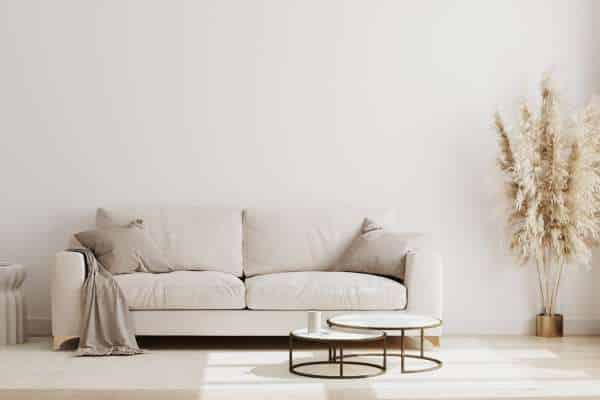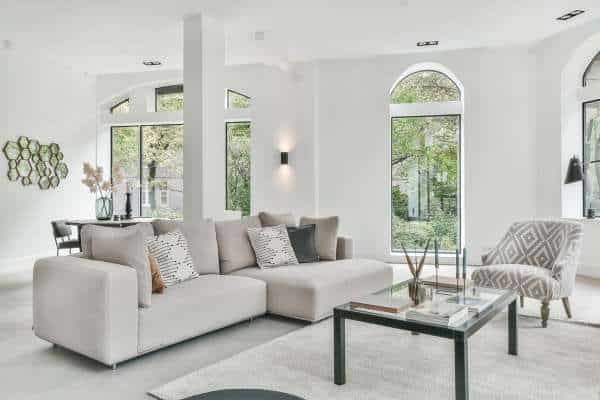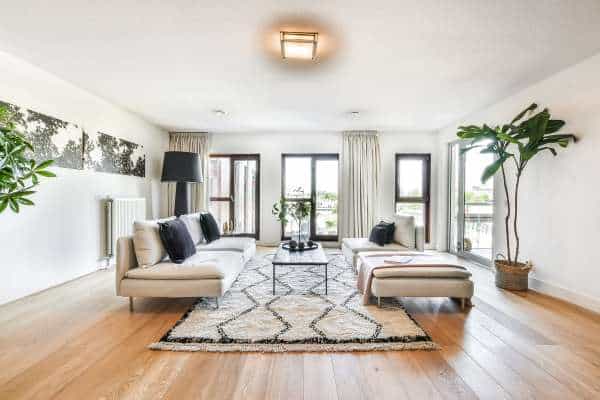Floating a sofa in a living room is a design technique that can transform the entire space. Unlike traditional setups where sofas are placed against walls, floating a sofa involves positioning it away from the walls, often in the center of the room. This approach not only improves the flow of the space but also creates distinct areas within your living room, making it feel more open and inviting. In this guide on how to float a sofa in a living room, we’ll explore the benefits, strategies, and best practices to help you achieve a stylish and functional layout that enhances your home’s overall aesthetic.
1. Assessing Your Living Room Layout

Assessing your living room layout is the first step to successfully floating a sofa. Start by evaluating the size and shape of the area to determine how much space you have to work with. This will help you choose the best position for the sofa. Next, identify potential focal points, such as a fireplace, TV, or large windows, which can guide where the sofa should be placed to enhance the room’s visual appeal. Additionally, consider the traffic flow and pathways around the sofa—ensure there is enough space for easy movement without obstructing natural walkways.
2. Choosing the Right Sofa

Choosing the right sofa is crucial when planning a floating arrangement in your living area. Start by selecting a couch size and style that complements the room’s dimensions and overall design. A couch that’s too large can overwhelm the space, while one that’s too small might feel lost. Consider modular or sectional sofas for added flexibility—they can be easily rearranged to suit different layouts and provide more seating options. It’s also important to balance the sofa with other furniture pieces, such as coffee tables, side tables, and chairs, to create a cohesive look.
3. Positioning the Sofa

Is a key element in successfully floating it in your living area. Depending on the layout and function of the space, you can explore different placement options to enhance both style and practicality.
Central Placement
Placing the sofa at the center of the area offers several benefits. It serves as a focal point, drawing attention and creating a sense of balance. This arrangement works particularly well in large rooms, where the couch can anchor the space and create symmetry with surrounding furniture, such as chairs, coffee tables, or side tables.
Angled Placement
For a more dynamic and visually interesting layout, consider placing the sofa at an angle. This approach can help break up a boxy room and guide the flow of movement. By aligning the couch with a focal point, such as a fireplace or a TV, you can maintain a cohesive look while adding depth and interest to the area without disrupting its natural flow.
Open Concept Placement
In an open-concept space, floating the couch can be an effective way to define separate areas within a large area. By positioning the sofa strategically, you can create distinct zones, such as a living area and a dining area, while maintaining an open and airy feel. Read, How to choose living room rug. This placement helps to delineate spaces without the need for walls, making the room feel spacious and connected.
4. Complementing with Furniture and Decor

Start by placing accent furniture, such as coffee tables and side tables, around the floating sofa. These pieces not only add functionality but also help to frame the couch and enhance the room’s layout. Adding an area rug beneath the couch is another effective way to anchor it and define the space, making the floating arrangement feel intentional and grounded. Additionally, using lighting and accessories like floor lamps, throw pillows, and artwork can further enhance the overall aesthetic, drawing attention to the floating sofa and creating a warm, welcoming environment.
5. Creating Visual Balance
Creating visual balance is key when floating a sofa in your living room. Start by ensuring the couch is balanced with other large furniture pieces in the area, such as bookshelves, media consoles, or armchairs.
This prevents one piece from dominating the space and helps maintain a harmonious look. It’s also important to choose a couch that fits the scale of the area, ensuring it doesn’t overpower the area but rather complements the overall design. To further enhance balance, incorporate artwork and decor that ties the room together.
Strategically placed wall art, mirrors, and accessories can draw the eye around the space, creating a cohesive and well-proportioned layout that highlights the floating sofa without overwhelming the area.
6. Maximizing Space and Functionality

Maximizing space and functionality is essential when floating a sofa in your living area. The area behind the couch presents an opportunity for creative use, such as adding storage or additional seating. You can place a console table or shelving unit behind the couch to hold decorative items, books, or even extra seating options like stools or benches. This not only makes the most of the space but also enhances the room’s functionality. Additionally, floating the sofa allows you to create multi-functional zones within the living area, such as a reading nook, a small workspace, or a play area for children.
7. Common Mistakes to Avoid
When floating a sofa in your living room, it’s important to avoid common mistakes that can undermine the design. One key mistake is placing the couch too close to the walls, which defeats the purpose of floating and can make the space feel cramped. Instead, leave ample space around the couch to allow for better flow and a more open feel. Another mistake is ignoring room proportions—choosing a sofa that’s too large or too small for the space can disrupt the balance and harmony of the room. Additionally, overcrowding the space with too much furniture can make the area feel cluttered and chaotic.
Conclusion
Floating a sofa in your living room can dramatically enhance the space, offering both style and functionality. By carefully assessing your area layout, choosing the right couch, and positioning it thoughtfully, you can create a balanced and visually appealing environment. Complementing the floating arrangement with the right furniture, decor, and lighting further enhances the overall look, while avoiding common mistakes ensures your space remains open and inviting. With these strategies in mind, you can successfully float a couch in your living area, transforming it into a more dynamic and comfortable space that you’ll enjoy for years to come.

